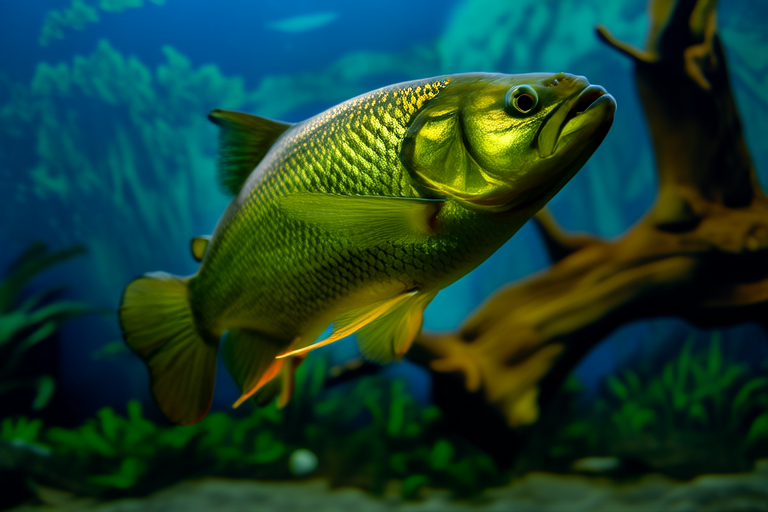Aquarium Mastery: Raising the Majestic Arowana
The arowana, also known as the dragon fish, is a fascinating and majestic creature that has captivated aquarium enthusiasts for centuries. With its sleek, elongated body and shimmering scales, this species is not only a sight to behold but also carries significant cultural and historical importance. This article will guide you through the intricacies of raising arowanas, from understanding their unique characteristics to setting up an ideal aquarium environment and maintaining their health.
Unique Characteristics and Historical Significance
Arowanas are native to tropical regions of Asia, South America, and Africa. They are known for their impressive jumping abilities and their ability to breathe air, which allows them to survive in low-oxygen environments. Historically, these fish have been revered in Asian cultures, where they are believed to bring good luck and fortune. In fact, in some parts of Southeast Asia, arowanas are considered a symbol of prosperity and are often given as gifts during important occasions.
The arowana’s appearance is equally striking. They come in various colors, including green, silver, red, and gold, each variety holding its own charm and appeal. Their large, pectoral fins are particularly noteworthy, making them excellent swimmers and adding to their graceful movements. These fish can grow quite large, reaching lengths of over three feet in captivity, making them a true centerpiece for any aquarium.
Optimal Tank Setup
Setting up an appropriate tank for arowanas is crucial for their well-being. Given their size and active nature, it is recommended to provide at least a 300-gallon tank for a single adult arowana. The tank should be spacious enough to allow ample swimming room and should have a sturdy lid to prevent the fish from leaping out. Arowanas are sensitive to changes in their environment, so maintaining a stable and secure habitat is essential.
Substrate choice is another important consideration. Sand or small gravel is preferable, as larger rocks or sharp objects could injure the fish. Decorations should be minimal to avoid stress and potential injuries. Live plants can add aesthetic value and help maintain water quality, but choose hardy species like Java ferns or Amazon swords that can withstand the fish’s robust behavior.
Water Parameters and Filtration Systems
Water quality is paramount for the health of arowanas. Optimal conditions include a temperature range of 78-84°F (25-29°C), a pH level between 6.5 and 7.5, and a hardness of 5-12 dGH. Regular testing of these parameters is advised to ensure consistency. Arowanas prefer slightly acidic to neutral water, and maintaining this balance is key to preventing health issues.
Filtration systems play a critical role in keeping the water clean and oxygenated. A high-quality external filter that provides both mechanical and biological filtration is essential. Additionally, a powerful powerhead or air pump can enhance water circulation and oxygen levels. It is important to note that while arowanas are capable of breathing air, they still require well-oxygenated water to thrive.
Diet Requirements and Feeding Habits
Arowanas are carnivorous and require a diet rich in protein. In the wild, they feed on insects, smaller fish, crustaceans, and occasionally plant matter. In captivity, it is advisable to provide a varied diet that mimics their natural food sources. Suitable foods include live or frozen feeder fish, shrimp, worms, and commercially available pellets designed for predatory fish. Feeding should be done carefully, as overfeeding can lead to obesity and related health problems.
Feeding frequency depends on the age and size of the fish. Younger arowanas may require more frequent meals, while adults can be fed every other day. It is crucial to observe your fish’s appetite and adjust feeding amounts accordingly. Providing a diverse diet ensures that they receive all necessary nutrients, promoting longevity and vibrant coloration.
Maintaining Water Quality and Managing Tank Mates
Regular maintenance is vital to keep the aquarium environment healthy. Weekly water changes of about 20% are recommended to remove accumulated waste and maintain water quality. Proper waste management helps prevent diseases and keeps the water parameters stable. Additionally, monitoring ammonia, nitrite, and nitrate levels is crucial for early detection of potential issues.
Selecting appropriate tank mates is another aspect to consider. Arowanas are territorial and can become aggressive towards other fish, especially those resembling their natural prey. However, some peaceful bottom-dwelling species like loaches or catfish can coexist harmoniously. It is essential to research compatibility thoroughly before introducing new inhabitants to the tank.
Behavioral Patterns and Encouraging Natural Behaviors
Arowanas exhibit fascinating behaviors that are a joy to observe. In the wild, they are known for their jumping prowess, often leaping out of the water to catch flying insects. To encourage this natural behavior in captivity, you can introduce floating insects or use specialized feeding techniques. Watching your arowana leap and capture its prey can be a thrilling experience for both you and your guests.
Another notable behavior is their curiosity and interaction with their surroundings. Arowanas are intelligent fish that can recognize their caretakers and may even respond to stimuli. Providing interactive elements like floating toys or gentle tapping on the glass can stimulate their minds and promote engagement.
Responsibilities of Ownership
Owning an arowana is a significant commitment that requires dedication and knowledge. These fish are long-lived, with lifespans ranging from 10 to 20 years, depending on care and genetics. Ensuring their health and happiness involves continuous learning and adaptation. As an owner, it is your responsibility to stay informed about the latest advancements in arowana care and to be prepared for the challenges that come with maintaining a large, active fish.
In conclusion, raising arowanas is a rewarding endeavor that offers both beauty and challenge. By understanding their unique characteristics, providing optimal living conditions, and fostering natural behaviors, you can enjoy the majesty of these magnificent creatures in your home aquarium. Embrace the journey of aquarium mastery and celebrate the presence of these dragon fish in your aquatic world.
